Ferry M. Direct Stripcasting of Metals and Alloys: Processing, Microstructure and Properties
Подождите немного. Документ загружается.

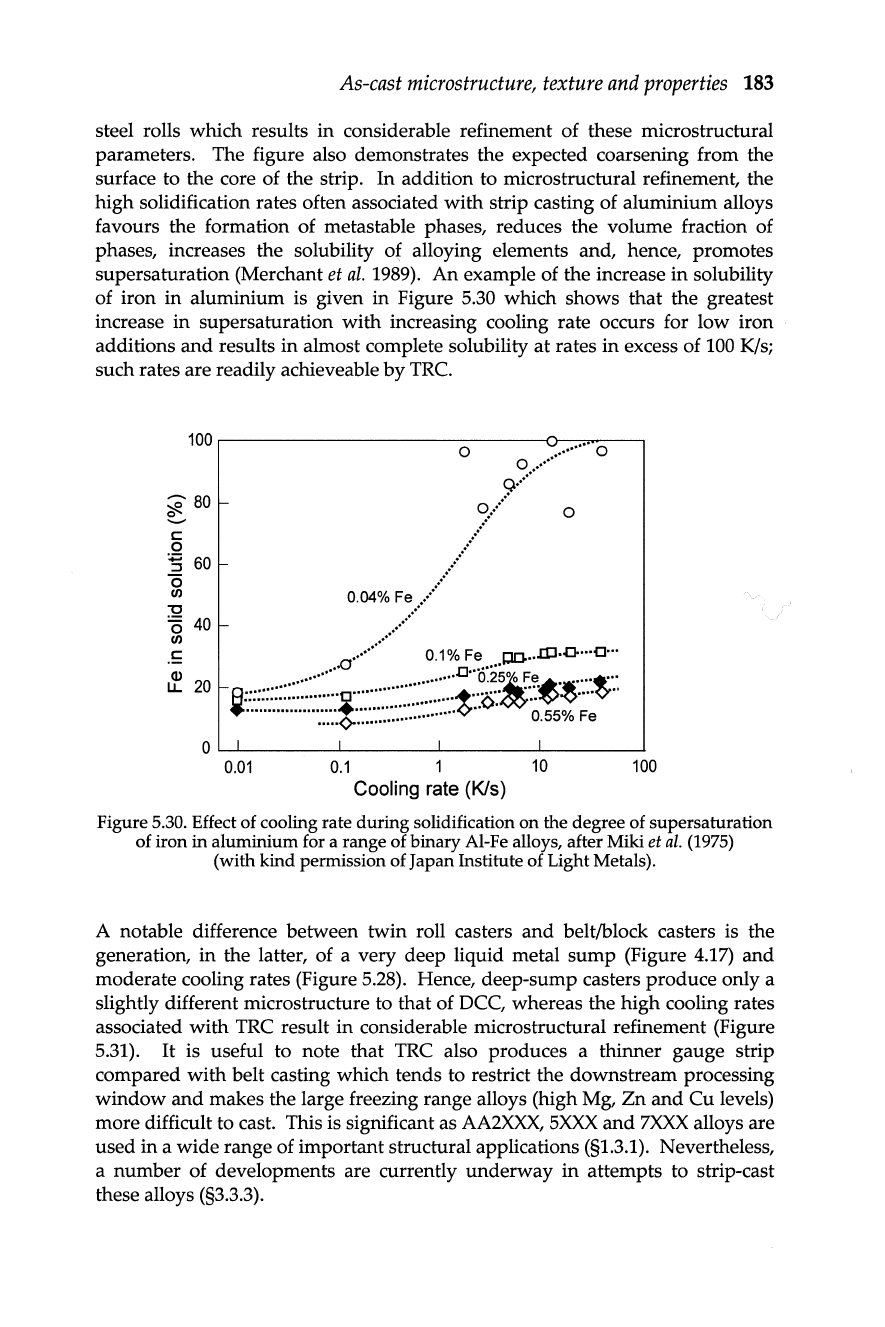
As-cast
microstructure,
texture
and
properties
183
steel rolls which results in considerable refinement of these microstructural
parameters. The figure also demonstrates the expected coarsening from the
surface to the core of the strip.
In
addition to microstructural refinement, the
high solidification rates often associated with strip casting of aluminium alloys
favours the formation of metastable phases, reduces the volume fraction of
phases, increases the solubility
of alloying elements and, hence, promotes
supersaturation (Merchant
et
ai.
1989).
An
example of the increase
in
solubility
of iron
in
aluminium is given in Figure
5.30
which shows
that
the greatest
increase in supersaturation
with
increasing cooling rate occurs for low iron
additions
and
results
in
almost complete solubility at rates
in
excess of
100
K/s;
such rates are readily achieveable
by
TRe.
100
~
80
C>
......,
c::
0
:;::::;
60
::s
"0
II)
:2
40
"0
II)
.S
Q)
20
LL
0
o 0
..
:::········0
Q
•••••••
0
••
•••·•
0
..
'
.'
.......
l
..
'
0.04% Fe
••••••••
'\f
.'
..•..•.••.
•••••••
0.1% Fe
po
..
m.o-
..
·o···
.,.0
.0
•••••.••
i
..........
··········..
.
.......................
~
..
?;~~~f.~
.....
:::
.•..
:.
....................
!
........
<>~
..
~'Q.~
· ....
··
.. ······
..
·
..
·····
..
···
..
·
...
·
..
·
..
·······055
0I
F
....
.............
•
fO
e
I I I I
0.01
0.1
1
10
100
Cooling rate (K/s)
Figure
5.30.
Effect
of
cooling rate during solidification
on
the degree
of
supersaturation
of
iron in aluminium
for
a range
of
binary
AI-Fe
alloys,
after
Mild
et
al.
(1975)
(with kind permission
of
Japan Institute
of
Light
Metals).
A notable difference between twin roll casters and belt/block casters is the
generation, in the latter, of a very deep liquid metal
sump
(Figure
4.17)
and
moderate cooling rates (Figure 5.28). Hence, deep-sump casters produce only a
slightly different microstructure to that of DCC, whereas the high cooling rates
associated
with
TRC
result
in
considerable microstructural refinement (Figure
5.31).
It
is useful to note that TRC also produces a thinner gauge strip
compared with belt casting which tends to restrict the downstream processing
window
and makes the large freezing range alloys (high Mg,
Zn
and
Cu
levels)
more difficult to cast. This is significant as
AA2XXX,
5XXX
and
7XXX
alloys are
used
in
a wide range of important structural applications (§1.3.1). Nevertheless,
a number of developments are currently underway
in
attempts to strip-cast
these alloys
(§3.3.3).
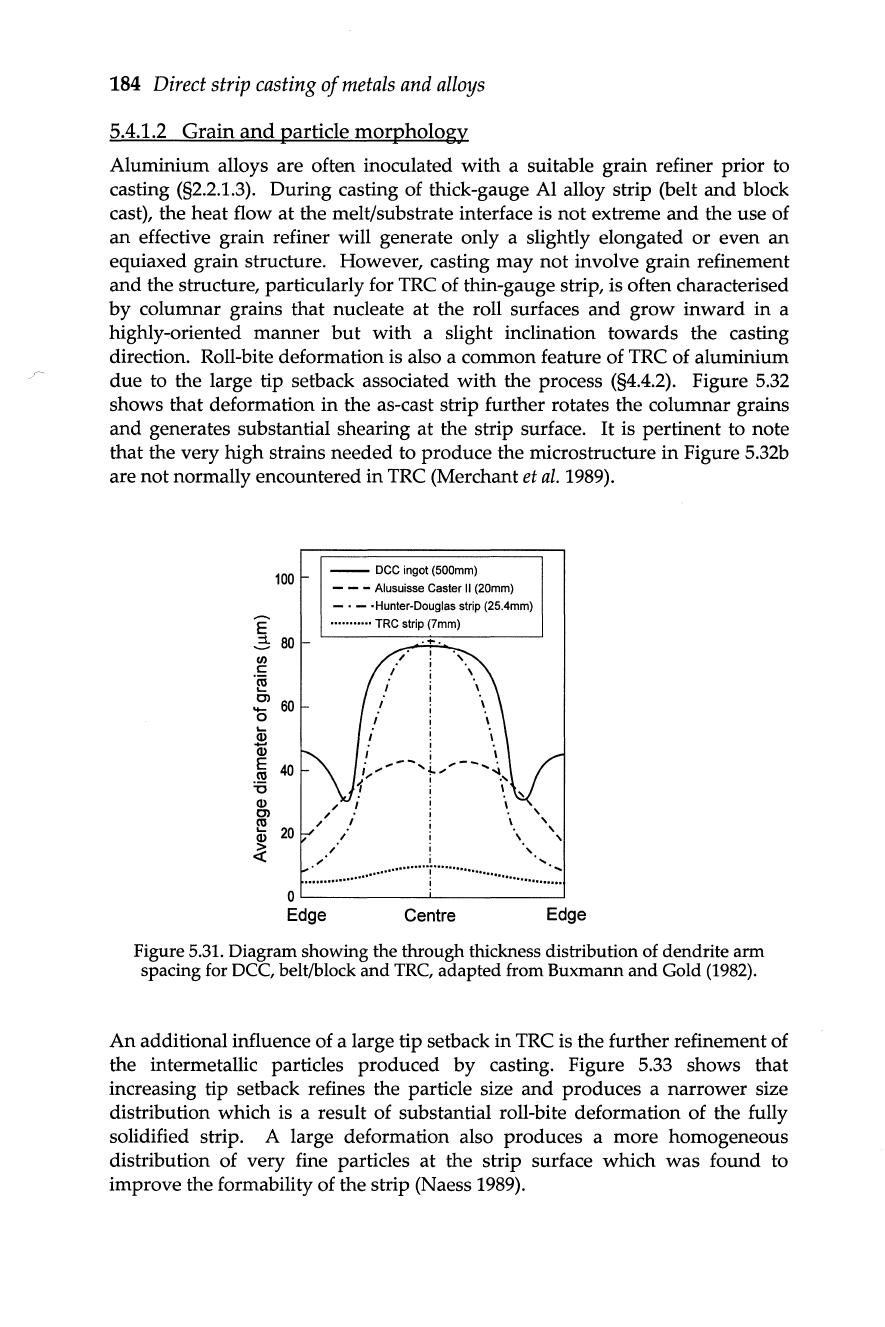
184
Direct
strip
casting
of
metals
and
alloys
5.4.1.2
Grain
and
particle
morphology
Aluminium alloys are often inoculated
with
a suitable grain refiner
prior
to
casting (§2.2.1.3). During casting of thick-gauge Al alloy strip (belt
and
block
cast), the
heat
flow
at
the melt/substrate interface is
not
extreme
and
the use of
an
effective grain refiner will generate only a slightly elongated
or
even
an
equiaxed grain structure. However, casting
may
not
involve grain refinement
and
the structure, particularly for TRC of thin-gauge strip, is often characterised
by
columnar grains
that
nucleate at the roll surfaces
and
grow
inward
in
a
highly-oriented
manner
but
with a slight inclination
towards
the casting
direction. Roll-bite deformation is also a common feature of TRC of aluminium
due
to the large tip setback associated
with
the process (§4.4.2). Figure 5.32
shows
that
deformation
in
the as-cast strip further rotates the columnar grains
and
generates substantial shearing
at
the strip surface.
It
is pertinent to note
that the very
high
strains needed to produce the microstructure
in
Figure 5.32b
are
not
normally encountered
in
TRC
(Merchant
et
al.
1989).
100
--
DCC ingot
(SOOmm)
- - - Alusuisse Caster
II
(20mm)
- • - ·Hunter·Douglas strip (2S.4mm)
••••••••••• TRC
strip (7mm)
E
2,
80
_
L-
___
----:-;;-:-
____
...J
rn
c:
.~
~
60
o
....
~
E
.!!!
40
"0
Q)
Cl
~
20
I
\
, I \
;
....
'--,.i,.
........
--
....
~
~;'
I
.,
I \
. .
,
/ \
,
,
,
,
£
,,/
i '
......
. :
......
·························f···················
...........
:.:
o
Edge
Centre
Edge
Figure 5.31. Diagram showing the
through
thickness distribution of dendrite
arm
spacing for DCC, belt/block
and
TRC,
adapted
from Buxmann
and
Gold (1982).
An
additional influence of a large tip setback
in
TRC is the further refinement of
the intermetallic particles produced
by
casting. Figure 5.33 shows
that
increasing tip setback refines the particle size
and
produces a narrower size
distribution which is a result of substantial roll-bite deformation of the fully
solidified strip. A large deformation also produces a more homogeneous
distribution of very fine particles at the strip surface which
was
found to
improve the formability of the strip (Naess 1989).
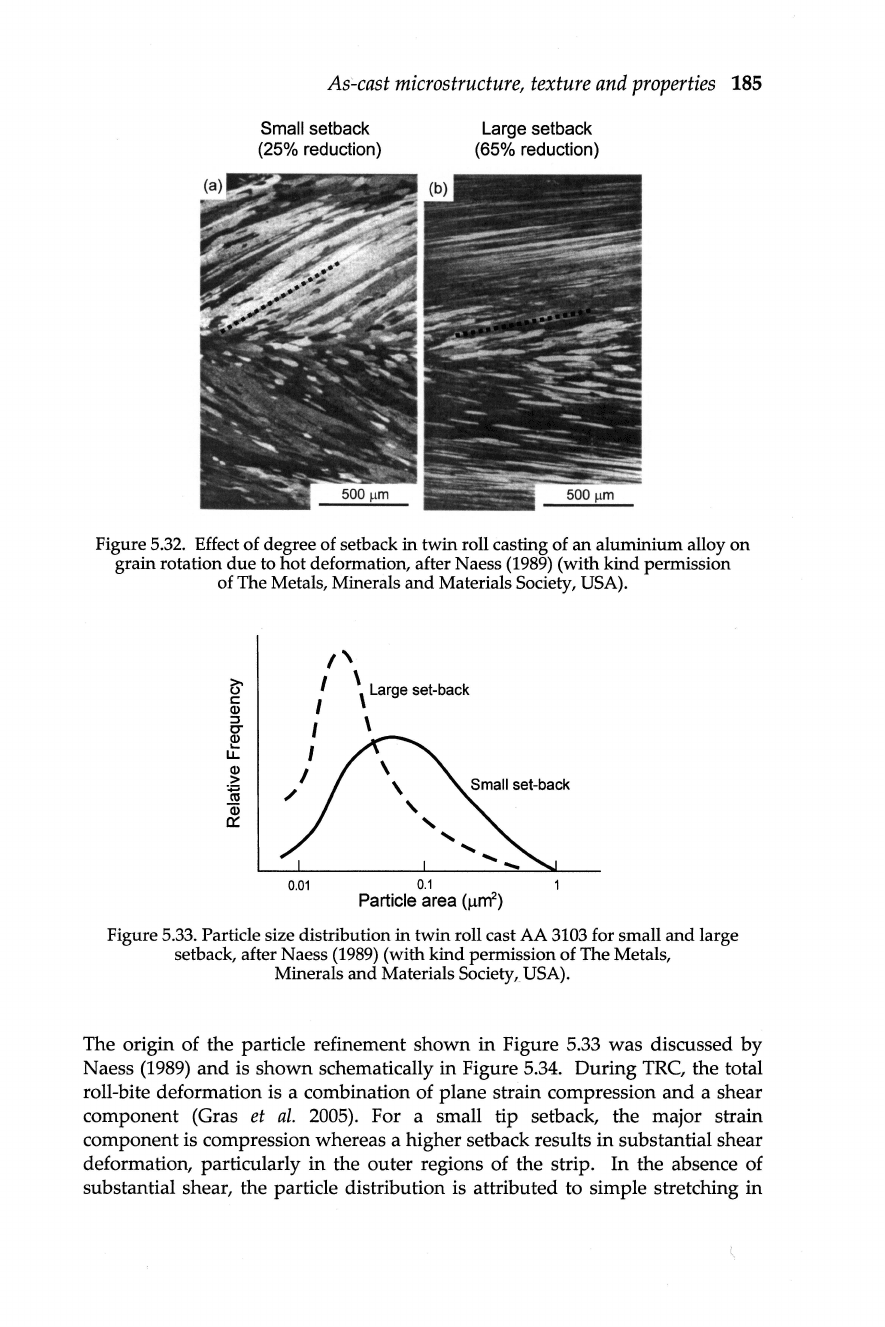
As'-cast
microstructure, texture
and
properties
185
Small setback
(25% reduction)
Large setback
(65% reduction)
Figure 5.32. Effect of degree of setback in twin roll casting of
an
aluminium alloy
on
grain rotation
due
to
hot
deformation, after Naess (1989) (with kind permission
of The Metals, Minerals
and
Materials Society, USA).
I'
f
/"
Large set-back
~
I \
u..
I
~
1
~
/
Qi
0::
0.01
0.1
Particle area (/-lot)
Figure 5.
33.
Particle size distribution in twin roll cast AA 3103 for small
and
large
setback, after Naess
(1989)
(with kind permission of The Metals,
Minerals
and
Materials Society, USA).
The origin of the particle refinement shown in Figure 5.33 was discussed
by
Naess
(1989)
and
is shown schematically in Figure 5.34. During TRC, the total
roll-bite deformation is a combination of plane strain compression
and
a shear
component (Gras
et
al.
2005)
. For a small tip setback, the major strain
component is compression whereas a higher setback results in substantial shear
deformation, particularly in the outer regions of the strip. In the absence of
substantial shear, the particle distribution is attributed to simple stretching in

186
Direct
strip
casting
of
metals
and
alloys
the rolling direction (Figure 5.34a) whereas a large shear leads to heterogeneous
deformation
which
tends to break
up
the grains into blocks
in
order
to retain
continuity
in
the material (Figure 5.34b). Hence, the particles
produced
by
casting will
be
sheared
in
the thickness direction to
produce
a finer size
and
narrower
size distribution, Figure 5.33.
No
shear
Large
shear
---====:====----
~
----=~
~--=---=-=:
::::=----
(a)
(b)
Figure
5.34.
Schematic illustration
of
the influence
of
inhomogeneous deformation
during
TRe
on the disintegration
of
the as-cast structure, after Andersson and Tibballs
(1989)
(with kind permission
of
The
Metals, Minerals and Materials
Society,
USA).
5.4.1.3 Texture development
While
<001>
dendritic
growth
is expected
in
most
fcc
metals (Table 2.2), there
are
numerous
reports of other
growth
morphologies
in
a range of Al
and
eu
alloys (Henry
et
al.
1998).
During
semi-continuous casting, these alloys often
develop grains of feathery morphology
that
are
not
composed of regular
<001>
dendrites
but
<011>
primary
dendrite arms
in
which the higher
order
<011>
arms
are
twin
related.
During
directional solidification, these grains
undergo
a
selection mechanism similar to
that
observed for
<001>
dendritic grains
that
eventually generates a strong
<011>
fibre texture.
Other
exotic dendritic
morphologies
have
been
observed including
untwinned
<011>
dendrites
that
form
under
high
thermal gradients
and
solidification rate
and
other
degenerate
feathery morphologies
with
<011>
primary
arms
and
<001>
secondary arms
(Henry
et
al.
1998).
In light of the different
growth
behaviour of dendrites associated
with
rapidly-
cooled Al alloys, strip-cast textures
in
Al alloys
may
be
different to those
produced
in
other cubic metals.
One
of the first reliable studies of of texture
development
in
twin
roll casting
was
carried
out
by
Radonjic
et
al.
(1982)
on
AA1050.
In
the strip interior (Figure 5.35a) there is a well-developed texture
with
maximum
intensity reasonably close to the
{110}<112>
(brass) components.
The brass texture is expected for grains of feathery morphology if the
aforementioned
<011>
growth
selection operates
during
directional

As-cast
microstructure,
texture
and
properties
187
solidification.
It
is pertinent to note, for the same alloy,
that
the
addition of a
grain refiner
during
casting generates
an
essentially equiaxed microstructure
with
a strong
{lll}<uvw>
and
weaker
{100}<01l>
texture component (Figure
5.35b).
CD
CD
~--------+---------~TD
Figure 5.35. 111 pole figures of
twin
roll cast
AA
1050
showing
the
texture
at
the
strip
interior for: (a)
no
grain
refinement,
and
(b) grain refinement,
adapted
from Radonjic et
al.
(1982).
Andersson
and
Tibballs
(1989)
carried
out
a detailed
study
of
the
effect
of
roll
bite deformation
in
a 7 rom gauge Al alloy
produced
by
twin
roll casting
and
found
that
the degree of tip setback has a notable influence
on
texture
development (Figure 5.36). A small tip setback
produced
a TO-rotated
{1l0}<001>
(Goss) texture just below the strip surface (Figures 5.36a(i)
and
5.36a(ii» which developed into a strong texture
in
the
core
of
the
strip
with
maximum intensities
near
{1l0}<1l2> (Figure 5.36a(iii».
In
contrast, the
additional deformation caused
by
a large tip setback resulted
in
substantial
shear
in
the surface regions
of
the strip (see Figure 5.32). Despite
the
slightly
higher
true
strain
(6
-0.3), shearing generated a substantially different texture
in
these regions
with
peak
intensities close to
{100}
<
011
>
and
{1ll} <
uvw
>
(Figure 5.36b(i». These texture components are similar to
that
observed
by
Radonjic
et
al.
(1982)
(Figure 3.35b). With increasing distance from the strip
surface, there
was
a gradual change to a TO-rotated
{1l0}<001>
texture (Figure
5.36b(ii» and, finally, to a classic {1l2}<1l1> (eu-type) rolling texture
at
the core
of the strip
due
to the substantial plane strain deformation
in
this region (Figure
5.36b(iii».
The results
shown
in
Figure 5.36 are largely consistent
with
the recent
work
of
Gras
et
al.
(2005)
whereby AA3105
was
twin roll cast to 2 rom gauge strip
and
the texture examined
both
in
the vicinity of the surface
and
core of the strip.
Taking their casting parameters (roll diameter
of
400
mm
and
feed metal tip
setback of 35-55 rom),
and
estimating a
sump
depth
of
-10
mm
at
a casting

188
Direct
strip
casting
of
metals
and
alloys
speed of
4.5
m/min
(Figure 4.19), Eq.
4.1
predicts a rolling strain ranging from
44
to
72%
reduction
during
casting. Figure 5.37 shows
(jJ2
=0
0
and
(jJ2
=45
0
sections in Euler space of the texture
at
the surface
and
core of the as-cast strip.
At
the strip surface, the notable texture components are
{l00}
<
011
> and
{Ill}
< uvw > which are similar to the texture components in cold rolled bee
metals (Figure 6.11). These texture components are also similar to that shown
in Figures 5.35b
and
5.36b(i). In contrast, the core of the as-cast strip has
developed a weak
eu-type
rolling texture
(,B-fibre),
similar to that shown in
Figure 5.36b(iii).
Overall, microstructure and texture development
in
strip-cast aluminium alloys
differs from that in ferrous alloys
due
to the different growth morphologies of
the dendrites, possible grain refinement
by
inoculation in aluminium
and
the
large deformations associated
with
casting. The type
and
strength of the
texture of as-cast aluminium strip is expected to have a strong influence
on
the
texture following cold rolling
and
annealing (§6.6.3.3), which
in
turn
affects the
formability of the material (§6.7.1.3).
CD
CD
O.7mm
(a) SMALL TIP SETBACK
CD
(b) LARGE TIP SETBACK
CD
1.7mm
CD
CD
3.5mm
Figure 5.36.
111
pole figures for various
depths
for a
medium
strength
AI-alloy strip
produced
by
twin
roll casting for:
(a)
small
and
(b)
large tip setback,
adapted
from Andersson
and
Tibballs (1989).
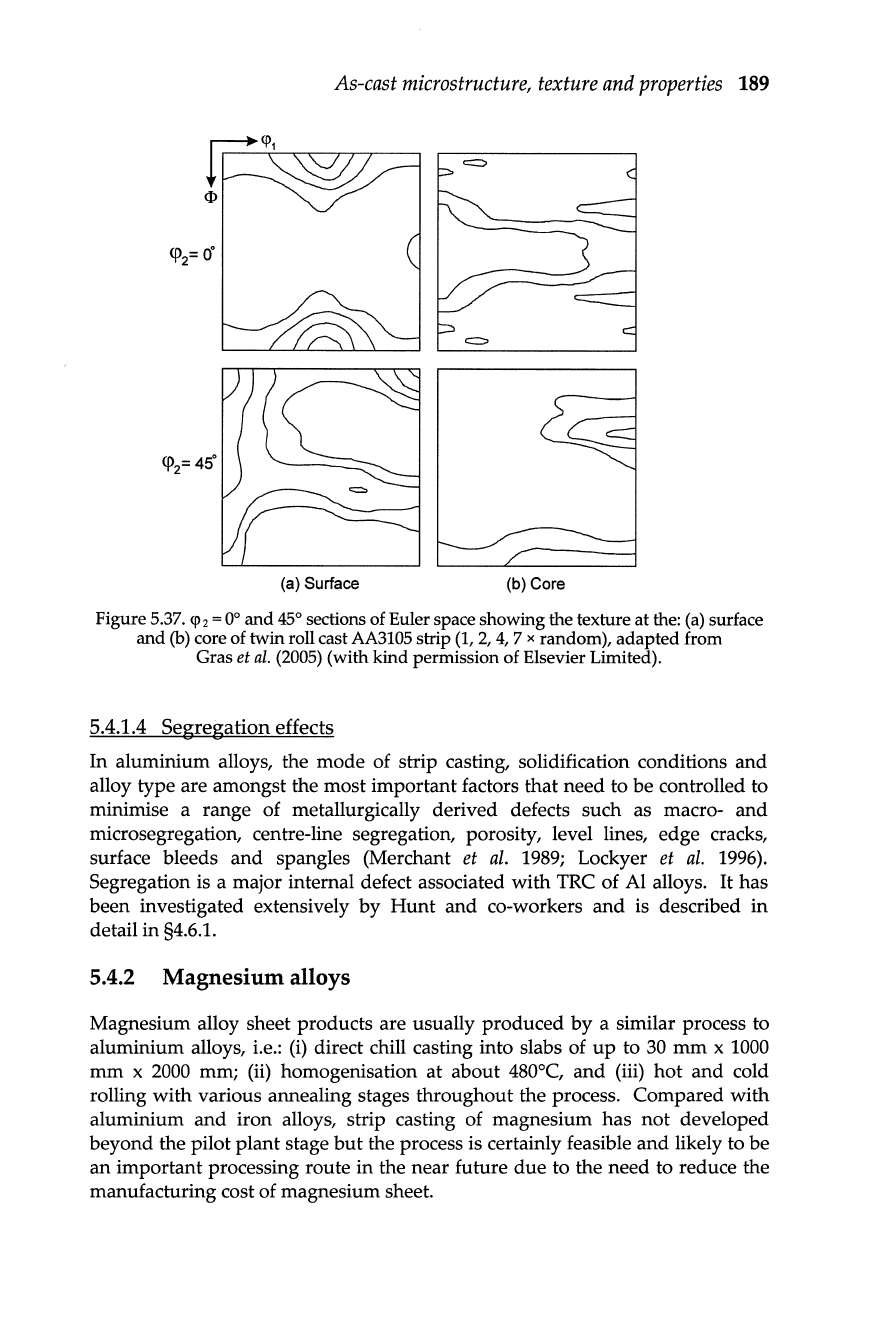
As-cast
microstructure,
texture
and
properties
189
(a) Surface
(b) Core
Figure
5.37.
</>2
=
0°
and
45° sections of Euler
space
showing
the
texture
at
the: (a) surface
and
(b) core
of
twin
roll
cast
AA3105
strip
(1,
2,
4,
7 x
random),
adapted
from
Gras
et
aI.
(2005)
(with
kind
permission
of
Elsevier Limited).
5.4.1.4
Segregation
effects
In aluminium alloys, the mode of strip casting, solidification conditions and
alloy type are amongst the most important factors that need to be controlled to
minimise a range of metallurgically derived defects such as macro- and
microsegregation, centre-line segregation, porosity, level lines, edge cracks,
surface bleeds
and
spangles (Merchant
et
al.
1989;
Lockyer
et
al.
1996).
Segregation is a major internal defect associated with
TRC
of Al alloys.
It
has
been investigated extensively
by
Hunt
and co-workers
and
is described
in
detail in §4.6.1.
5.4.2 Magnesium alloys
Magnesium alloy sheet products are usually produced
by
a similar process to
aluminium alloys, i.e.:
(i)
direct chill casting into slabs of
up
to
30
mm
x
1000
mm
x
2000
mm; (ii) homogenisation at about
480°C,
and (iii)
hot
and cold
rolling with various annealing stages throughout the process. Compared with
aluminium
and
iron alloys, strip casting of magnesium has
not
developed
beyond the pilot plant stage
but
the process is certainly feasible
and
likely to be
an important processing route
in
the near future
due
to the need to reduce the
manufacturing cost of magnesium sheet.

190
Direct
strip
casting
of
metals
and
alloys
To transform DSC into a commercial process for magnesium, the various
challenges outlined
in
Table
3.3
must be met. For example, the process must be
capable of producing strip from a wide range of alloys with different thickness
(especially below 4 mm) with the technology used
in
TRC
of Al alloys. The
process must have a high success rate at the commencement of a casting run, a
safe termination and use existing infrastructure for secondary processing such
as rolling and annealing operations. However, modification of the composition
of conventional alloys may be necessary
due
to the wide solidification range of
commercially-available Mg-AI-Zn alloys (Figure
1.12).
5.4.2.1
Cast
structure
and
texture
Like aluminium, Mg has no allotropic transformations
and
the degree of
structural refinement possible during casting is limited. Hence, the cast
structure can be altered only
by
further secondary processing such as
homogenisation,
hot
or cold rolling and annealing. At the time of writing, there
is very little published
on
the development of microstructure
and
properties of
Mg alloys produced
by
DSC (park
et
al.
2003,
2005;
Davey
et
al.
2004;
Liang
and
Cowley
2004;
Watari
et
al.
2004a,b). Liang and Cowley
(2004)
have reported
promising results for
TRC
of the commercially-significant Mg alloys AZ31,
AZ61, AM60
and
AZ91
(Table
2.8).
A range of thicknesses
down
to
2.5
mm
was
produced
at
cooling rates comparable to those found
in
aluminium alloys. A
similar refinement
in
microstructural parameters was generated including a
reduction
in
the size of both intermetallic particles
and
grains (Figure
5.28)
and
an
increase in solubility (Figure
5.30).
These factors resulted
in
a significant
improvement
in
the mechanical properties of the as-cast strips.
Nucleation and growth of grains during
DSC
of magnesium is expected to
occur
in
a manner similar to that
in
the alloys discussed previously. Although
there is very little documentation, the mode of casting (belts
or
rolls) and
casting parameters such as casting velocity, melt superheat
and
substrate
topography are all likely to affect the as-cast microstructure. Grain refiners may
also be added during casting to generate a finer, more equiaxed grain structure.
In the absence of inoculants, the as-cast grain structure of twin roll cast Mg
alloys is either equiaxed or columnar with the latter often producing a central
equiaxed zone. Park
and
co-workers
(2003)
have shown that a high melt
superheat favours dendritic growth
in
AZ31
(low freezing range alloy) which
subsequently generated a structure consisting of columnar grains inclined
in
the direction of casting
and
an equiaxed zone at the core of the strip. However,
they observed a fully equiaxed structure in
AZ91
which was attributed to the
wide freezing range of this alloy and the low melt superheat.
Figure
5.38
shows an increase
in
SDAS
with distance below the strip surface of
twin
roll cast
AZ31
and
AZ91
alloys; this behaviour is characteristic of all alloys
produced
by
DSC.
It
can also be seen that
AZ31
developed a finer dendrite arm
spacing than AZ91; this may be a result of the different melt superheats used

As-cast
microstructure,
texture
and
properties
191
during casting
(U8°e
for
AZ31
and
52°C
for AZ91). The higher melt superheat
in
AZ31
is expected to result in a high cooling rate and will result in refinement
of the dendrite arm spacing (see
Eq.
2.37).
The narrower freezing range
(/'!J.T
o
)
in
AZ31
compared with
AZ91
is also expected to contribute to the
SDAS
refinement, as predicted
by
Eq.
2.36.
E
2:
en
(§
7r-------------.,------------~
i
i
i
9 D
...
····p·······r·················
.
••
'
AZ91
.
d'"
.····0
i····
.
• ' .
d'
.....
i
.....
.
•••
[J
,
·.n
D"
..
'
.....
.....
•......
.......
.
5
en
3
.··········AZ··
31
·····iit··
.....
iii
•....
•••••••
"W
1
~------------~
__________
~
Edge
Centre
Edge
Distance from surface (mm)
Figure 5.38. SDAS as a function of distance from the as-cast surface of
twin
roll cast
magnesium alloys AZ31
and
AZ91, after Park
et
al.
(2003) (with
kind
permission of Trans Tech Publishers).
Unlike cubic metals, the preferred dendritic growth directions
in
hexagonal
metals are
<
1010>,
(Table
2.2);
this will generate different solidification
textures. As
in
other alloys, the alloy type, casting velocity together with other
casting variables (tip setback, roll diameter, final gauge, melt superheat etc.)
will affect the final microstructure and texture of as-cast magnesium strip.
Nevertheless, there are
no
reports
in
the open literature of texture development
in strip-cast magnesium alloys and further work is needed.
5.4.2.2
Potential
for
downstream
processing
The tendency to form coarse columnar grains
in
strip-cast magnesium may
result in problems with workability if the material is to be further processed
by
rolling or fabricated into a final shape. A coarse columnar structure can be
replaced
by
a more equiaxed structure
by
inoculation of the melt, a standard
practise
in
DeC
of these alloys, or by lowering the casting temperature.
However, there are several potential problems with inoculation
in
DSe
such as
nozzle clogging and upstream nucleation. Inoculation may
not
be necessary if
DSe
can generate a refined columnar structure or a fully equiaxed structure.
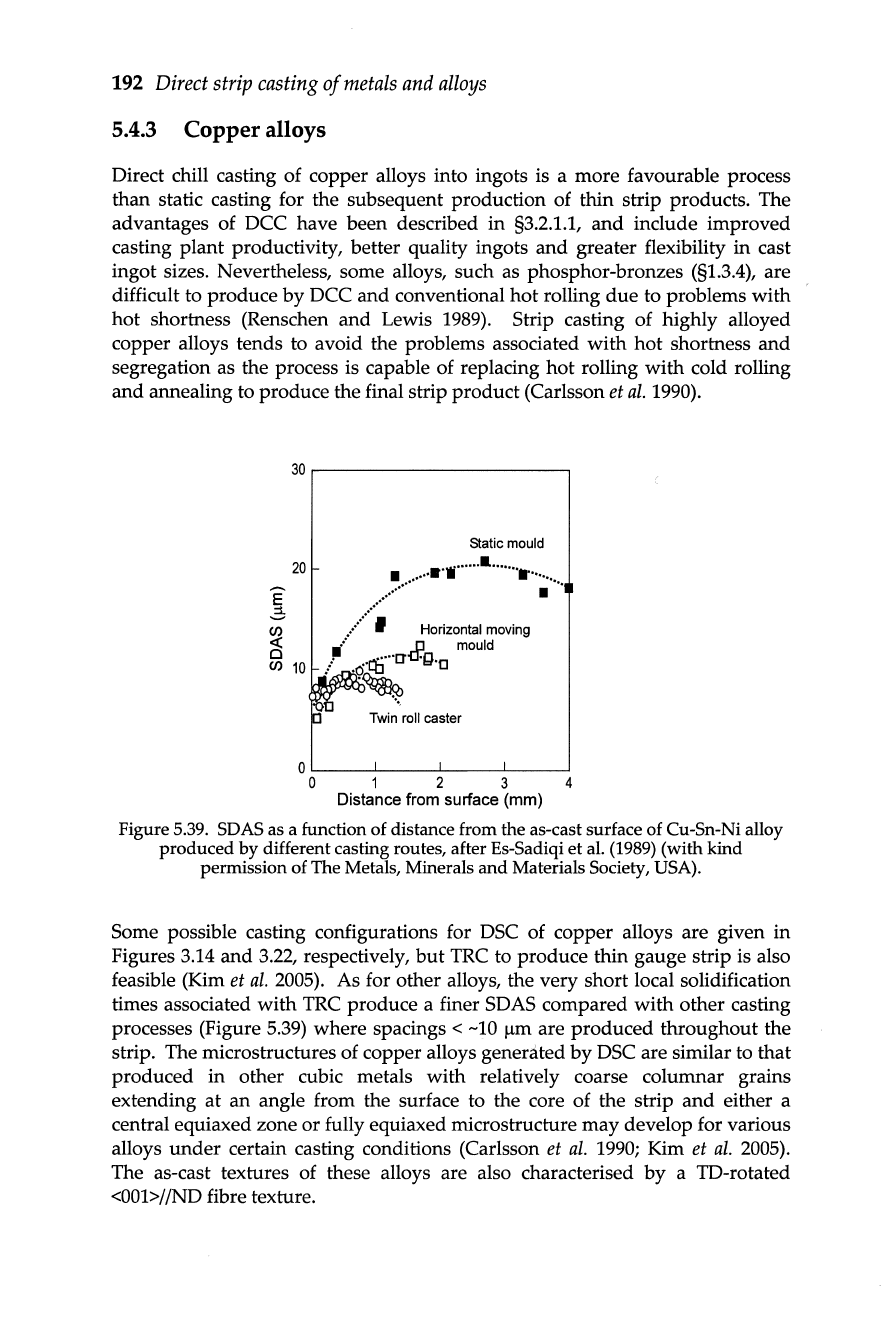
192
Direct
strip
casting
of
metals
and
alloys
5.4.3 Copper alloys
Direct chill casting of copper alloys into ingots is a more favourable process
than static casting for the subsequent production of
thin strip products. The
advantages of DCC have been described in §3.2.1.1, and include improved
casting plant productivity, better quality ingots
and
greater flexibility in cast
ingot sizes. Nevertheless, some alloys, such as phosphor-bronzes
(§1.3.4),
are
difficult to produce
by
DCC and conventional
hot
rolling
due
to problems with
hot shortness (Renschen and Lewis
1989). Strip casting of highly alloyed
copper alloys tends to avoid the problems associated with
hot
shortness and
segregation as the process is capable of replacing
hot
rolling with cold rolling
and annealing to produce the final strip product (Carlsson
et
al.
1990).
~
~
30~------------------~
Static
mould
20
...................
.
...•.
..
....
...............
~
....
.........
I Horizontal
moving
.l
[]
mould
C/)
10
! .
.....::···O{]·g·C
...
~
....
Twin
roll
caster
O~--~----~----~--~
o 1 2 3 4
Distance from surface (mm)
Figure 5.39. SDAS as a function of distance from the as-cast surface of Cu-Sn-Ni alloy
produced
by
different casting routes, after Es-Sadiqi
et
al. (1989) (with
kind
permission of The Metals, Minerals
and
Materials Society, USA).
Some possible casting configurations for
DSC
of copper alloys are given
in
Figures
3.14
and
3.22,
respectively,
but
TRC
to produce thin gauge strip is also
feasible (Kim
et
al.
2005). As for other alloys, the very short local solidification
times associated with
TRC
produce a finer SDAS compared
with
other casting
processes (Figure
5.39) where spacings <
-10
~
are produced throughout the
strip. The microstructures of copper alloys
genercited
by
DSC are similar to that
produced in other cubic metals with relatively coarse columnar grains
extending at an angle from the surface to the core of the strip
and
either a
central equiaxed zone or fully equiaxed microstructure may develop for various
alloys under certain casting conditions (Carlsson
et
al.
1990; Kim
et
al.
2005).
The as-cast textures of these alloys are also characterised
by
a TO-rotated
<OOI>//ND
fibre texture.
